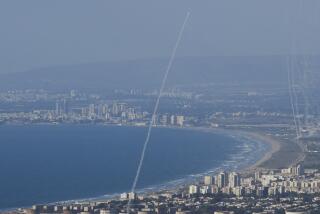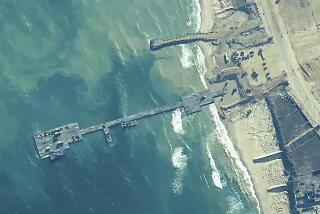Cargo Movers Keep Pace on a New Route
- Share via
BREMERHAVEN, Germany — Although the U.S. military had considerable experience shuttling troops and equipment between America and Europe, little consideration had been given before the Gulf conflict to transporting troops from Germany to other parts of the world.
The enemy--the Soviet Union and the Warsaw Pact--was nearby, just over the border to the east.
“Units in Germany never had a deployment mission,” says Col. Thomas C. Mills, who heads the Army unit responsible for loading military equipment onto ships at the port of Bremerhaven. “We were, in fact, deployed ourselves. Whatever you were going to do, you were going to do it right here. You weren’t getting ready to go somewhere else.”
But the military’s cargo movers feel they’ve proved they can keep pace with global events. The first shipload of ammunition and vehicles was stowed and sailing out of Bremerhaven within days of the Nov. 8 order transferring American units in Germany to the Persian Gulf.
Responsibility for the massive undertaking rests largely with the Navy’s Military Sealift Command (MSC) and the Army’s Military Traffic Management Command (MTMC). MSC procures the ships and coordinates their movement, while MTMC is responsible for getting the cargo loaded.
“We’re like the bus drivers,” says Navy Cmdr. Annette Brown, who heads the MSC office in Bremerhaven, the principal port in Germany for shipping and receiving military equipment. “You tell us where you want the ships, you tell us the capacity you need.”
The ships come from a variety of sources, including the MSC’s own Ready Reserve Force of mostly aging cargo haulers. American and foreign-flagged ships also are chartered to transport ammunition and equipment to the war zone.
Before the supplies are even brought to Bremerhaven for loading, they are fitted with bar-code stickers, like those on packaged goods at the supermarket. Usually, three stickers are placed on each item; they have a tendency to fall off in cold weather and other rugged conditions.
Once a ship is tied up in port to receive materiel for transshipment to the Gulf, the MTMC takes over.
As the equipment is unloaded, MTMC workers run a computer “wand” over the bar code to register its arrival. “I have the little scanners just like they do at (the grocery store), except I don’t run the equipment across the cash register,” says Mills, the MTMC commander at the port.
In military parlance, the word wand can be used as a verb: “I want you to wand those tanks over there.”
The computer stores information that identifies each piece of equipment and shows its source, destination, size and weight. “When you get done loading the ship, you just push a button and you can see how much the load weighs,” Mills explains.
Once a ship’s cargo--food, tanks, cluster bombs or whatever--has been scanned, the MTMC uses another computer system to determine how to load the supplies onto the ship.
“A lot of people think you just drive stuff on,” says Mills. “Well, in true point of fact, you don’t just drive stuff on. You try to maximize the cargo-carrying space on the ship. You have to stow the ship so it has stability and all that other kind of stuff Navy guys who drive ships are interested in.”
More to Read
Sign up for Essential California
The most important California stories and recommendations in your inbox every morning.
You may occasionally receive promotional content from the Los Angeles Times.













